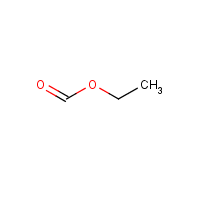Ethyl formate
Agent Name
Ethyl formate
Alternative Name
Formic acid, ethyl ester
CAS Number
109-94-4
Formula
C3-H6-O2
Major Category
Solvents

Synonyms
Formic acid, ethyl ester; Aethylformiat [German]; Areginal; Carboxylic acid oxaethane; Ethyl formate; Ethyl formate (natural); Ethyl formic ester; Ethyl methanoate; Ethyle (formiate d') [French]; Ethylester kyseliny mravenci [Czech]; Ethylformiaat [Dutch]; Etile (formiato di) [Italian]; Formic acid, ethyl ester; Formic ether; Mrowczan etylu [Polish]; [ChemIDplus] UN1190
Category
Esters (<C12)
Description
Colorless liquid with a fruity odor; [NIOSH]
Sources/Uses
Used as flavoring agent, solvent for nitrocellulose, and reagent in organic synthesis; Also used as a fungicide/larvicide for tobacco, cereals, and dried fruit; [ACGIH]
Comments
Liquid causes second degree burns after contact for a few minutes. [CHRIS] The anesthetic potency of ethyl formate is greater than ethanol, acetone, and alkanes such as pentane, but less than chlorinated hydrocarbons and ethyl ether. TLV Basis = upper respiratory tract irritant; Reported to be irritating at 321 ppm; [ACGIH] Esters may induce narcosis in animals, but workers' exposures are limited by irritating effects. See appendix in: [Dick RB, et al. Chemicals in the workplace: incorporating human neurobehavioral testing into the regulatory process. Am J Ind Med. 1998 May;33(5):439-53.] Inhalation of high concentrations causes drowsiness and unconsciousness; A skin, eye, and respiratory tract irritant; [ICSC]
Biomedical References
Exposure Assessment
Skin Designation (ACGIH)
Insufficient data
STEL (ACGIH)
100 ppm
PEL (OSHA)
100 ppm
MAK
100 ppm
IDLH (NIOSH)
1500 ppm
Excerpts from Documentation for IDLHs
It has been reported that 330 ppm produced slight eye irritation and rapidly increasing nasal irritation [Flury and Zernik 1931].
Vapor Pressure
245 mm Hg
Odor Threshold Low
18 ppm
Odor Threshold High
20 ppm
Lethal Concentration
LCLo (rat) = 8,000 ppm/4H
Explanatory Notes
Odor threshold from AIHA; Flash point = -20 deg C; VP = 200 mm Hg @ 20.6 deg C; [HSDB]
Reference Link #2
NFPA
may ignite at ambient temp
Adverse Effects
Neurotoxin
Acute solvent syndrome
Dermatotoxin
Skin burns
ACGIH Carcinogen
Not Classifiable
Diseases, Processes, and Activities Linked to This Agent
Diseases
Occupational diseases associated with exposure to this agent:
Processes
Industrial Processes with risk of exposure: